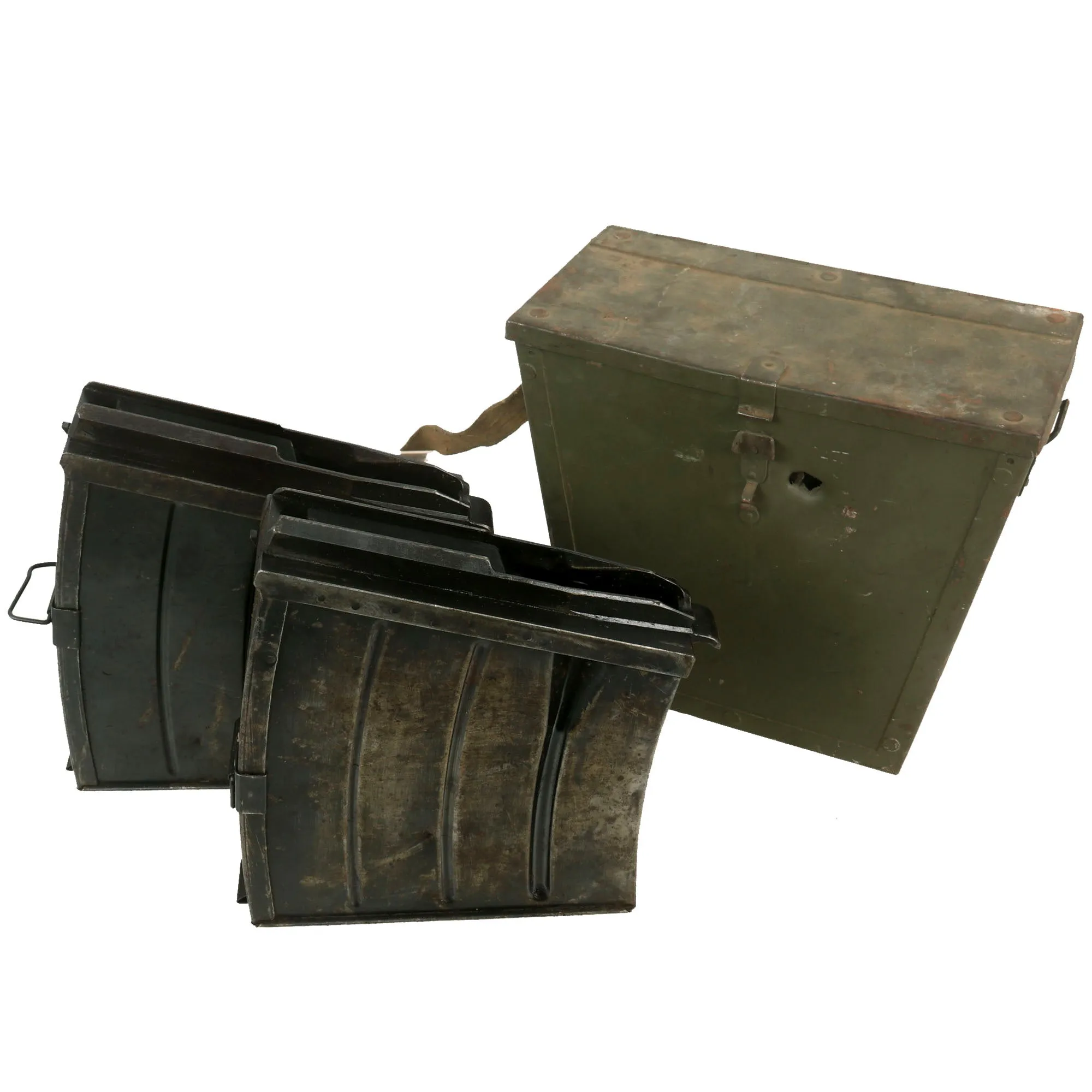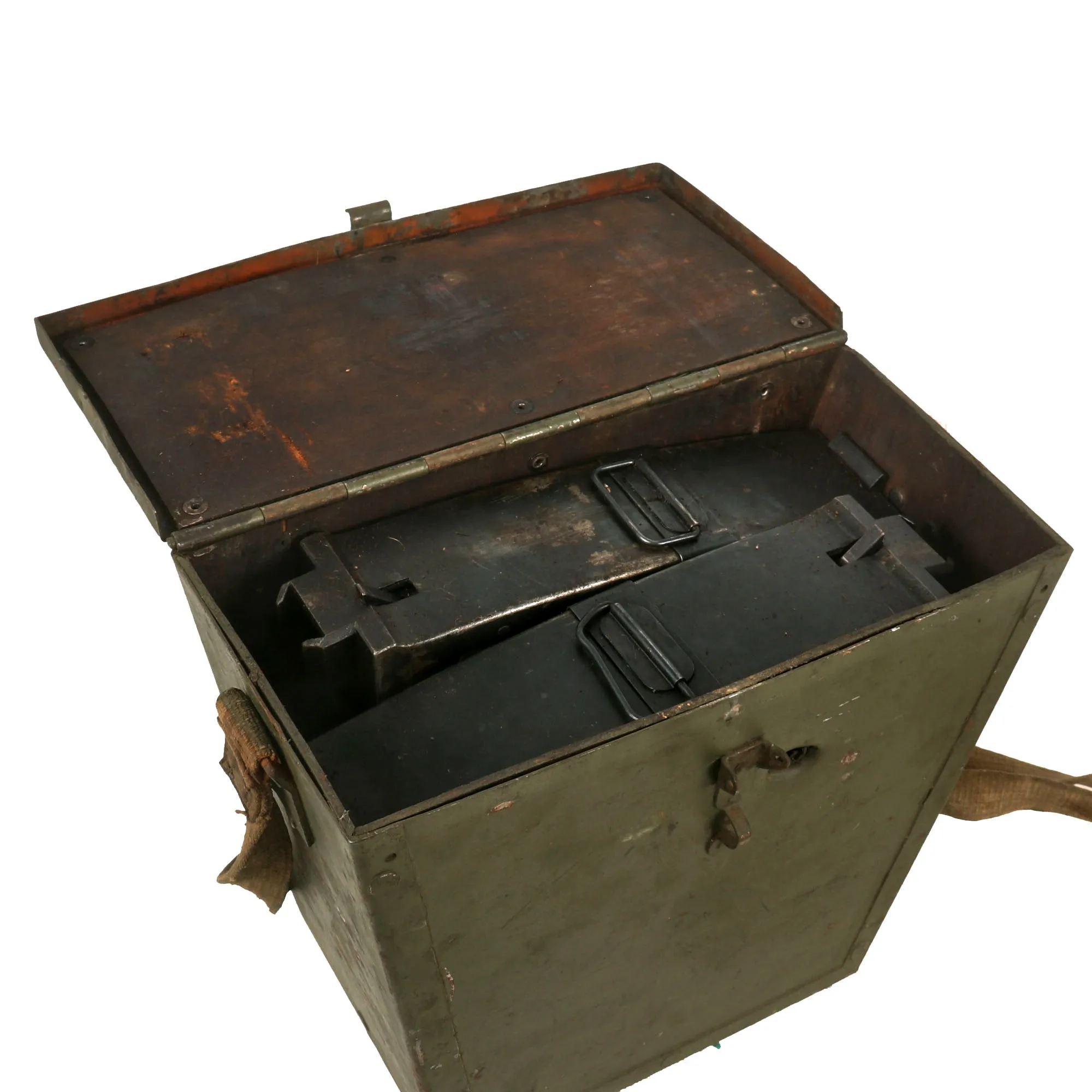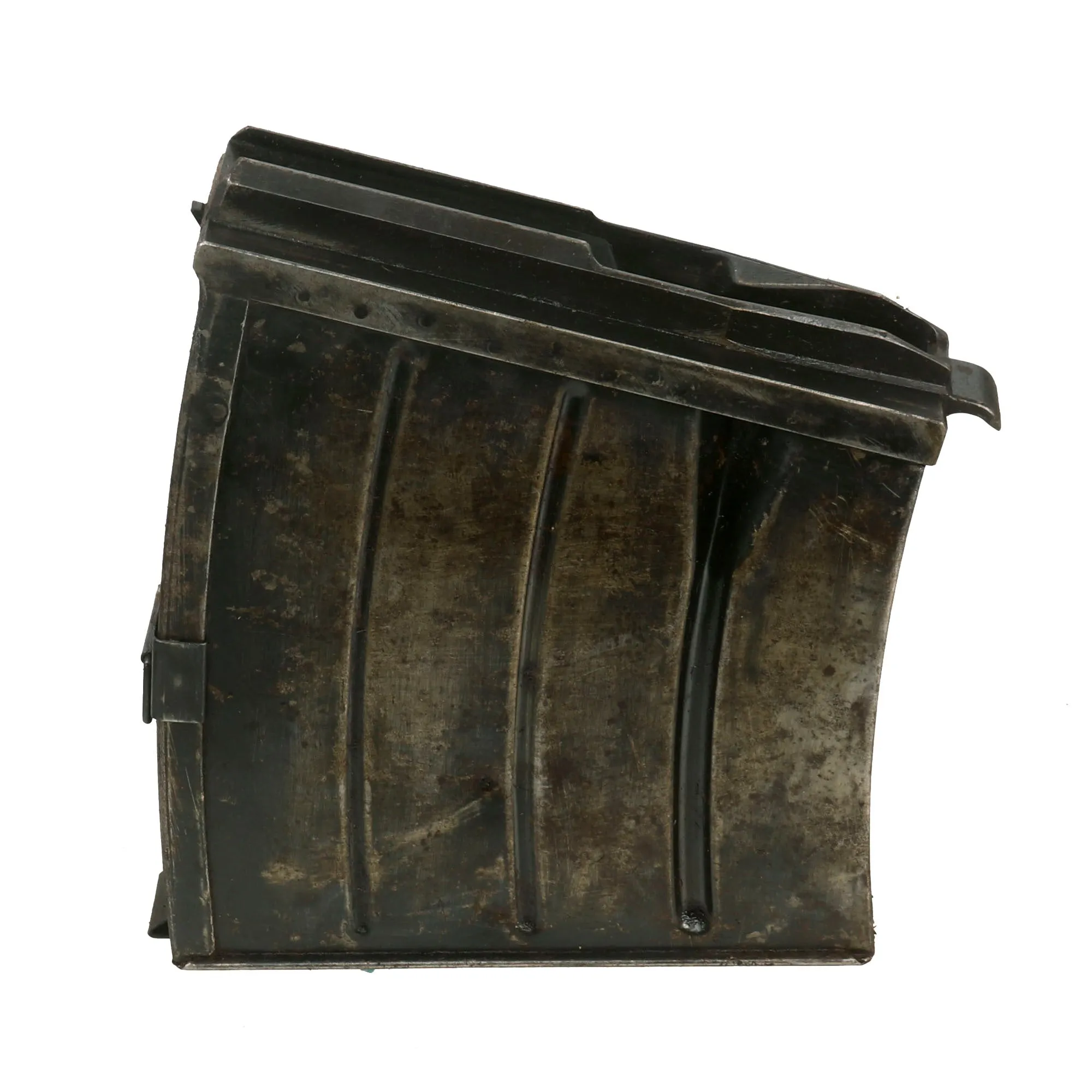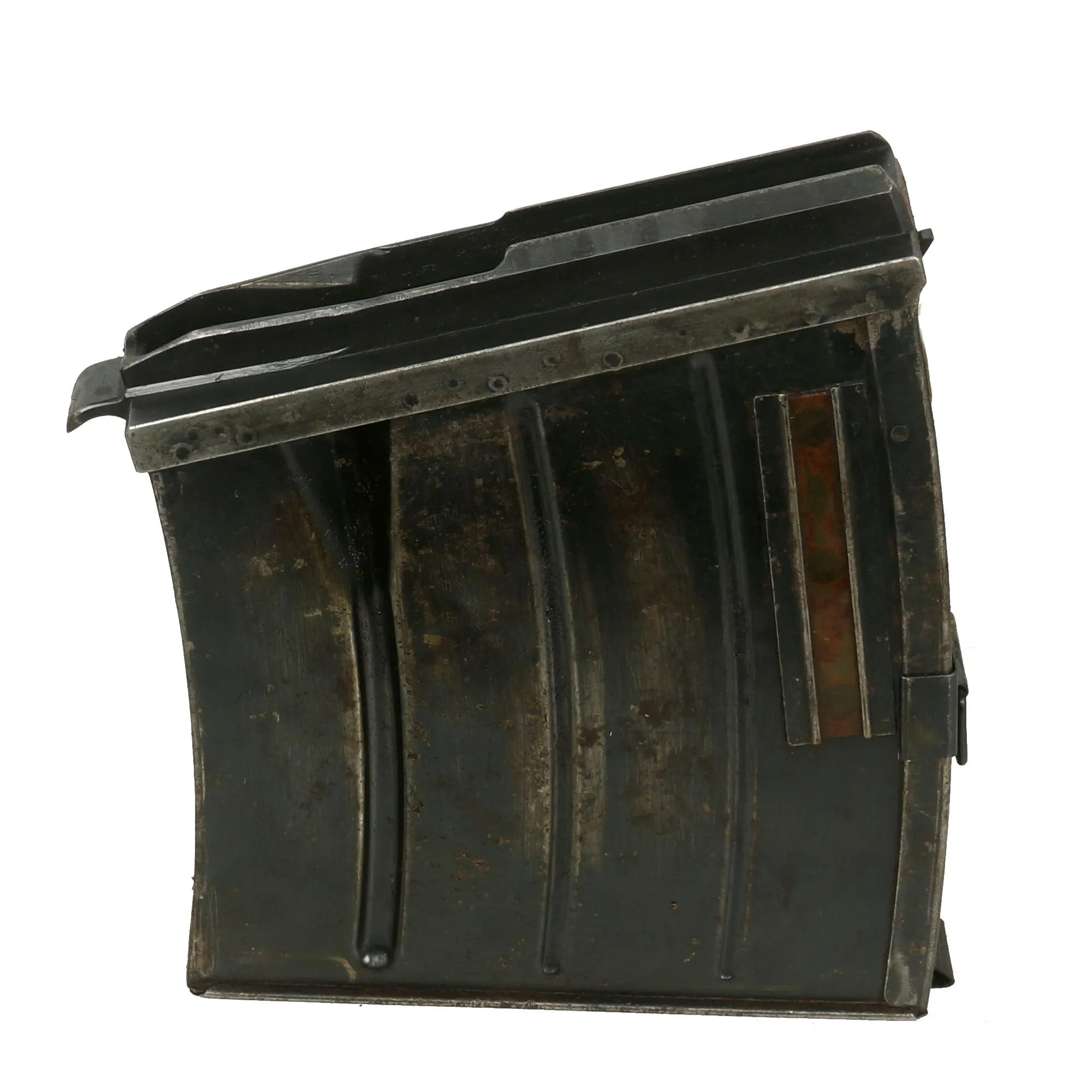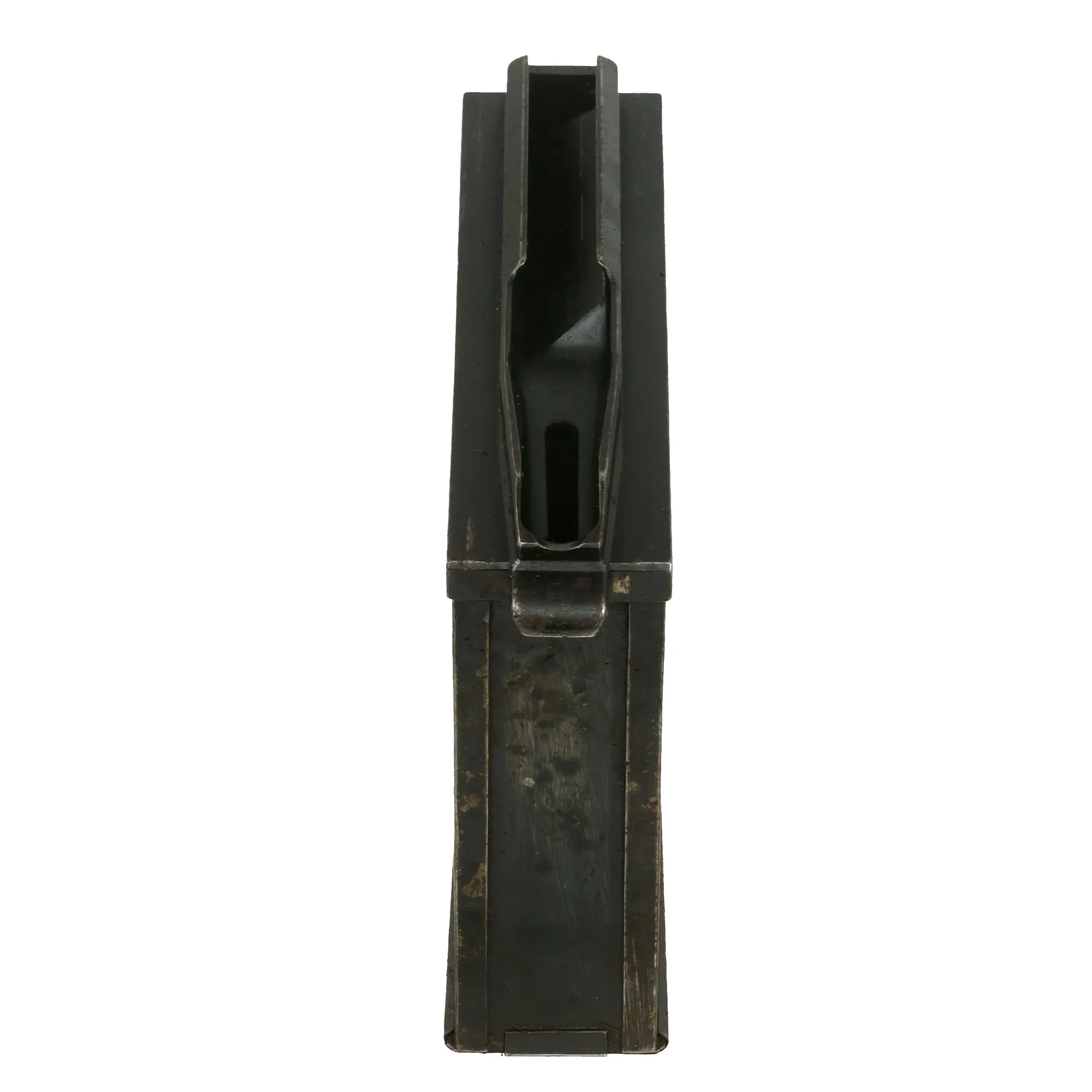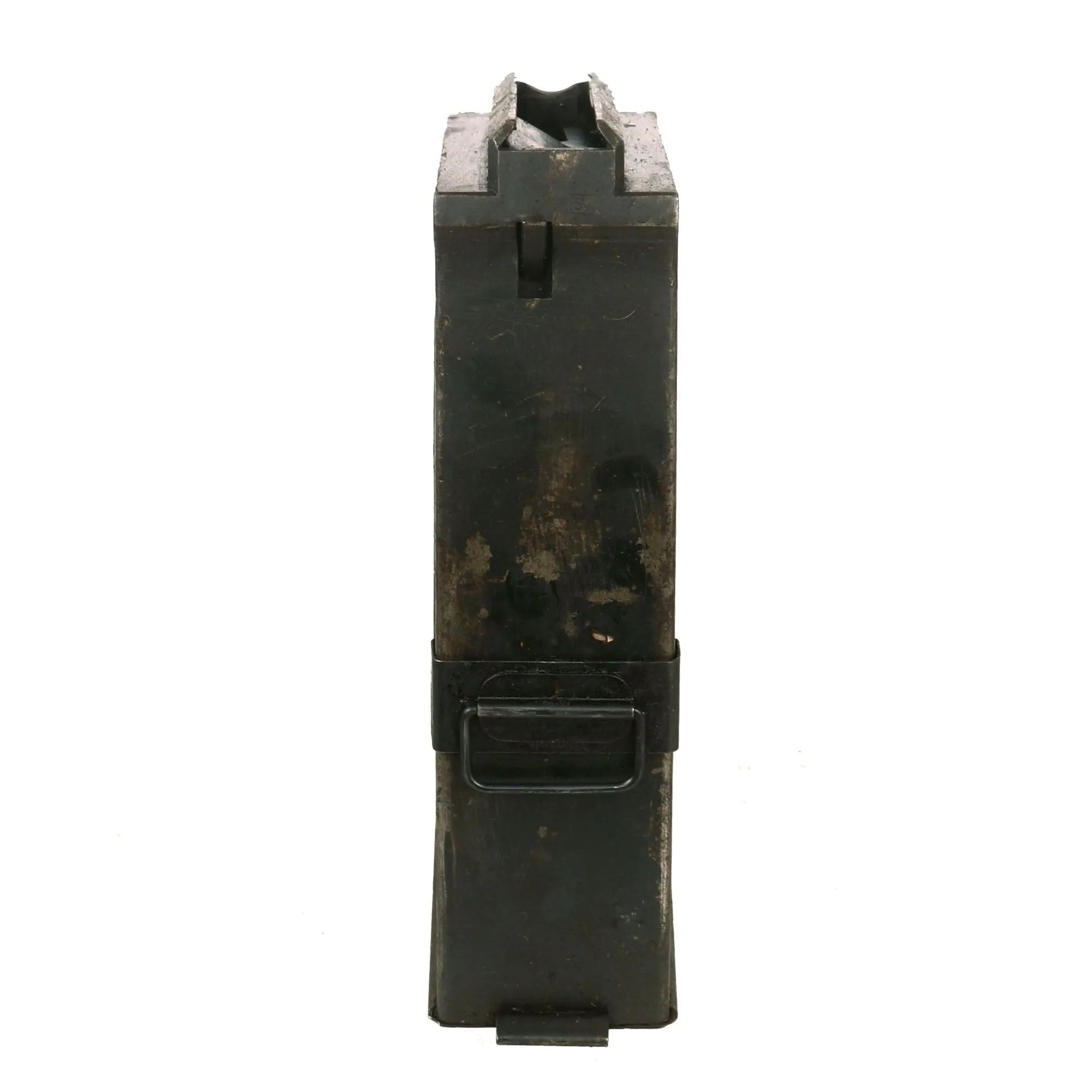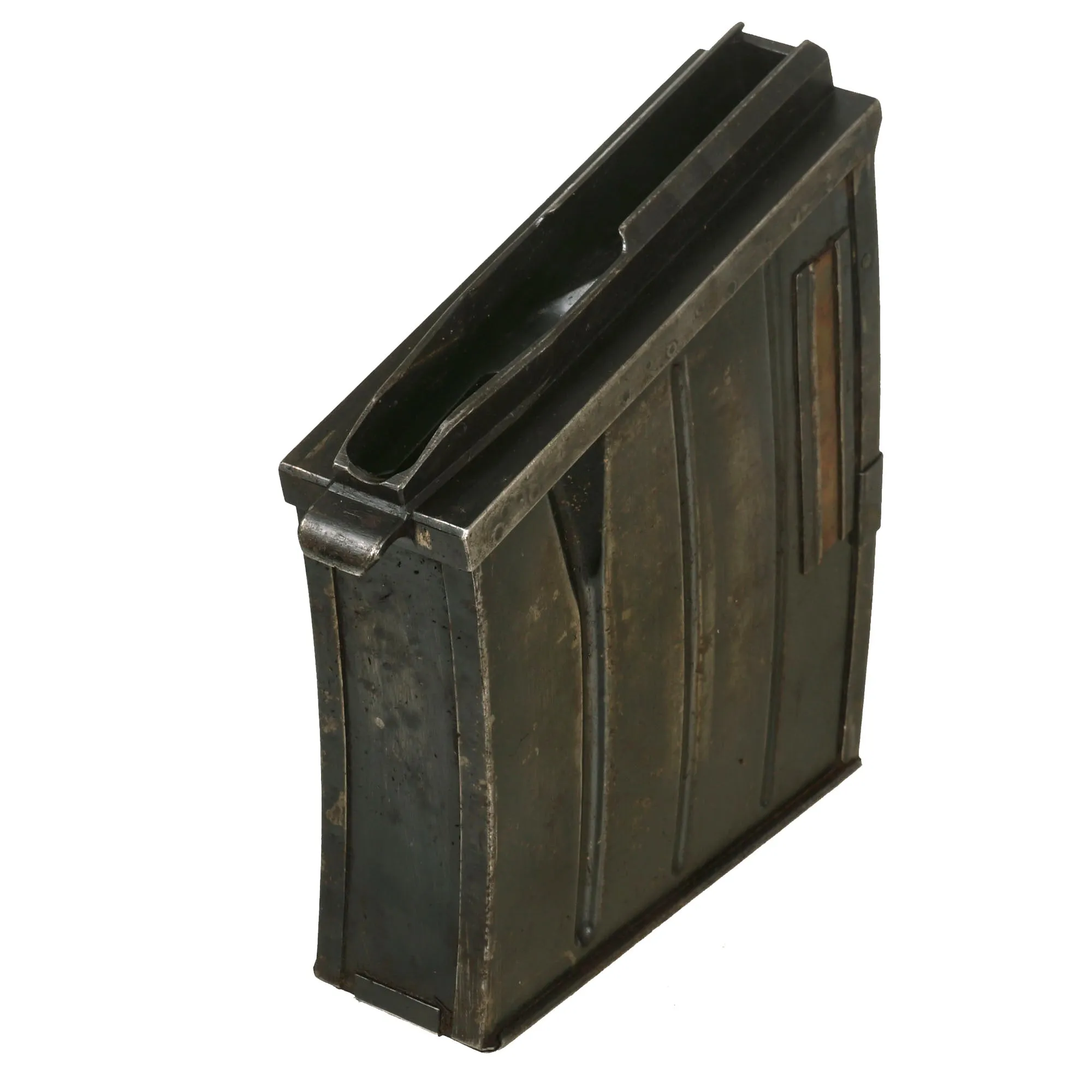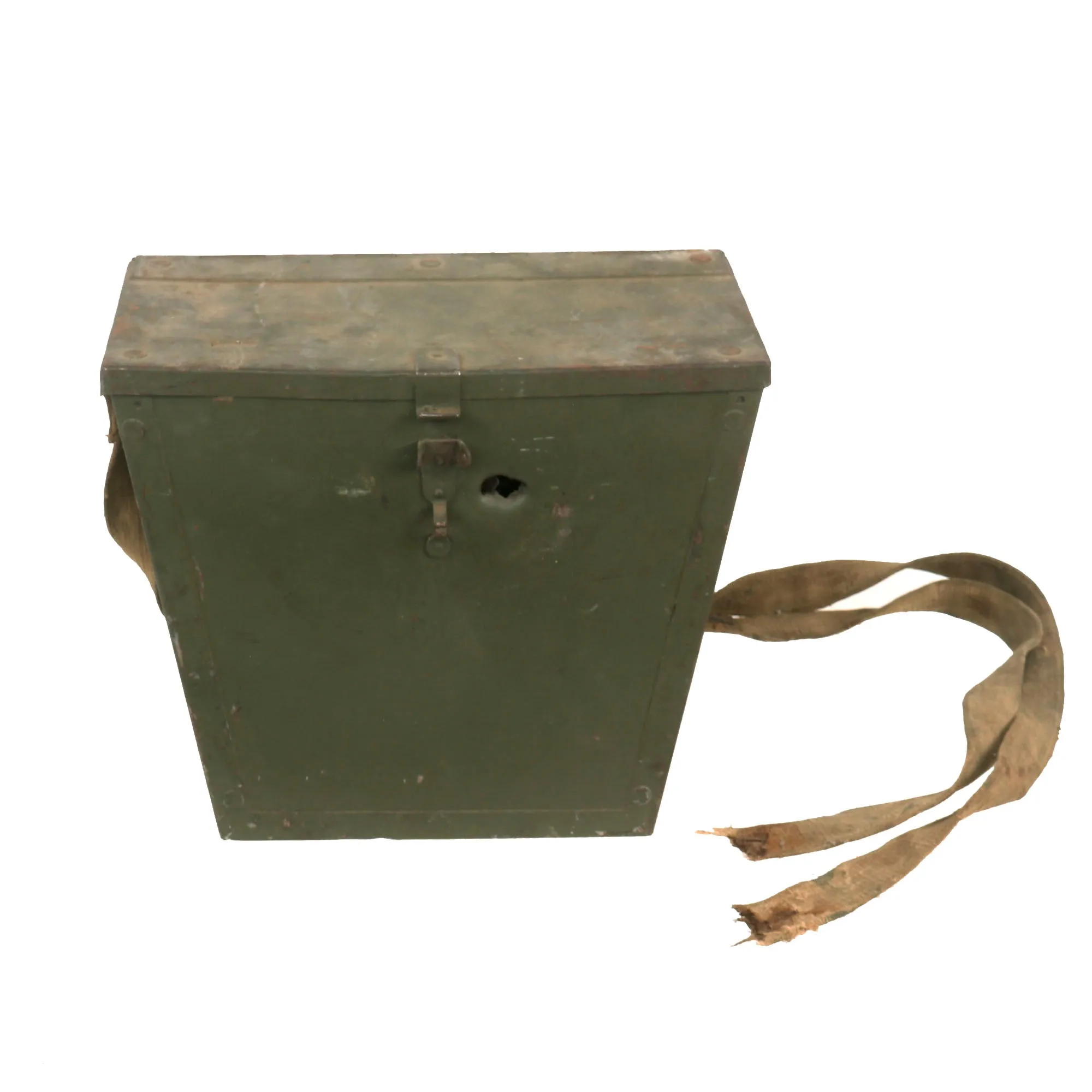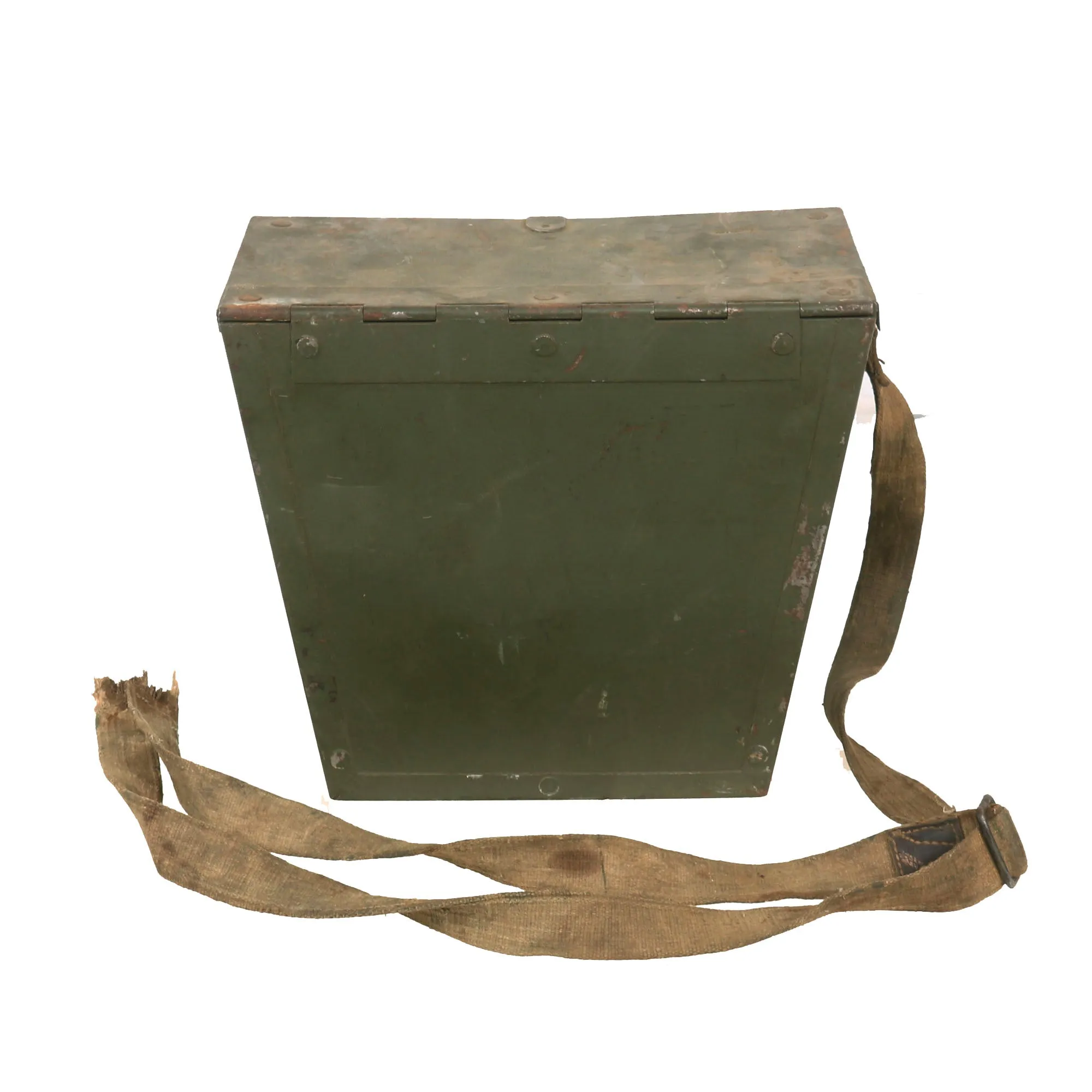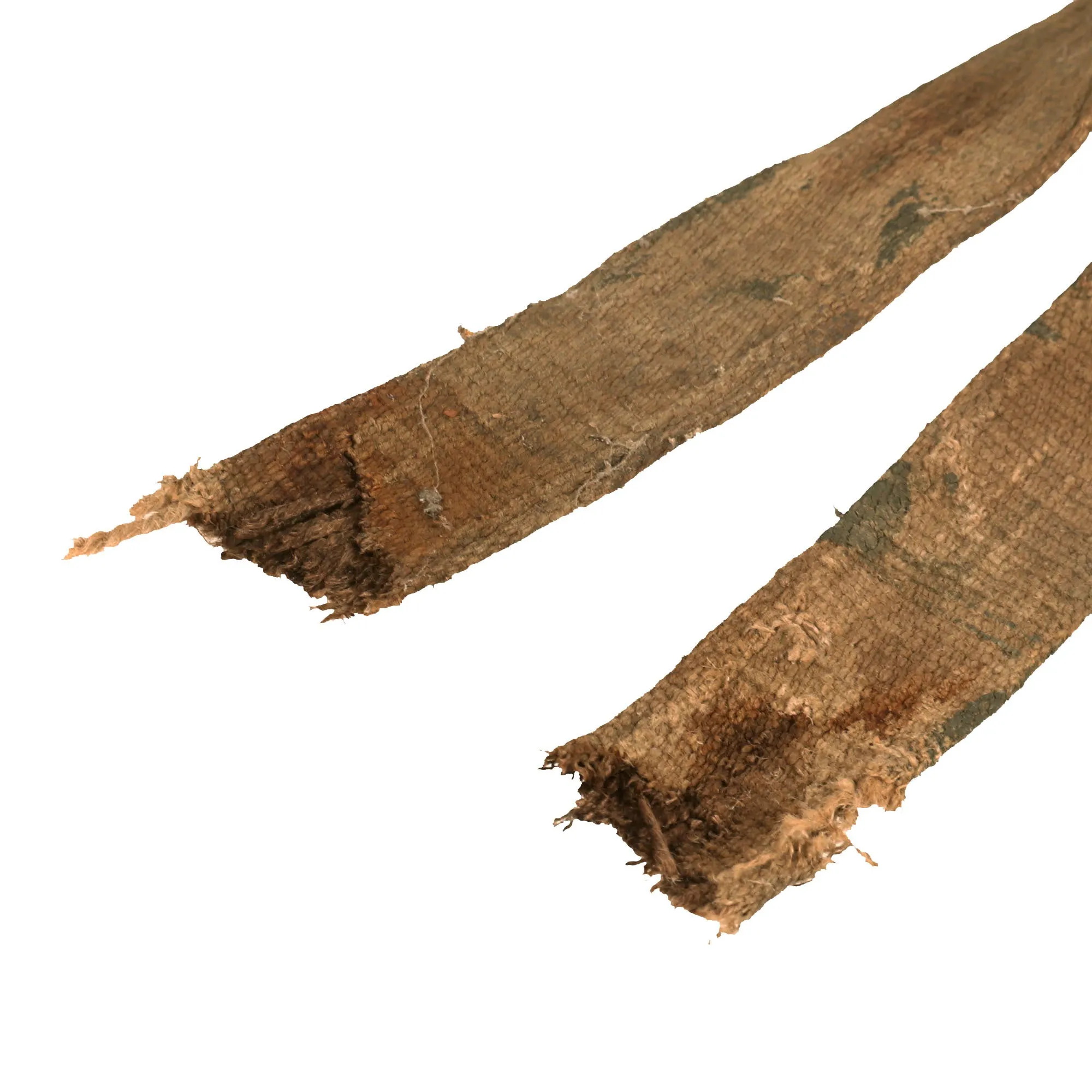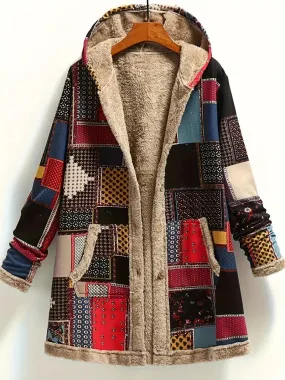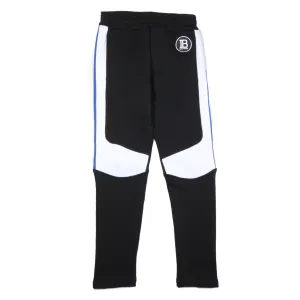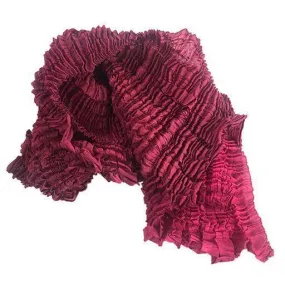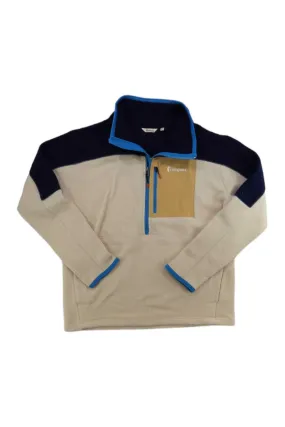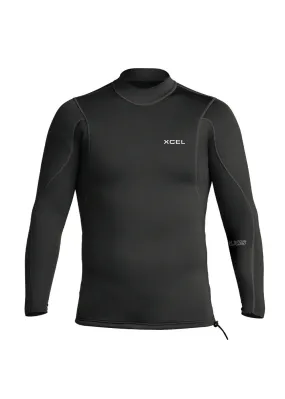Original Item. Only One Available. This is an extremely scarce Finnish transit case for two Lahti L-39 Anti-Tank Rifle Magazines with the original magazines still intact. The case is in good shape with its original carrying strap although it has broken off of one side and is very fragile, although it could be resewn for display. The carrying case measures roughly 12 x 10 x 6” when closed.
There is a small bit of shrapnel damage to the carrying case, in the form of a small shrapnel hole next to where the latch once was. Upon inspection of the magazines, the side facing the wall has a small dent perfectly aligned with the shrapnel damage hole, meaning this is a complete original set to WWII. The two magazines each measure 8¾ x 10⅜ x 2½” and are in good shape with some oxidation and storage wear. The case appears to have been repainted green at one point, as there appears to be repainting over the shrapnel damaged area.
This is truly a fantastic display piece, and we are unlikely to see another like it anytime soon. Ready to add to your collection and display!
The Lahti L-39 wass a Finnish 20 mm anti-tank rifle used during the Second World War. It had excellent accuracy, penetration and range, but its size made transportation difficult. It was nicknamed "Norsupyssy" ("Elephant Gun"), and as tanks developed armor too thick for the Lahti to penetrate, its uses switched to long range sniping, tank harassment and with the L-39/44 fully automatic variant, employment as an improvised anti-aircraft weapon.
Design:
Finnish weapons designer Aimo Lahti had doubts about the original idea of a 13 mm anti-tank machine gun and started working on a 20 mm design. Officers who wanted smaller caliber anti-tank weapons believed that the muzzle velocities of 20 mm shells were insufficient to penetrate armor, and a weapon with a higher rate of fire and in a smaller caliber would prove useful. As a result, Lahti designed two competing anti-tank weapons: a 13.2 mm machine gun and a 20 mm rifle. After test firing both weapons in 1939, they found that the 20 mm rifle achieved better penetration.
Operation:
The rifle is a semi-automatic, gas operated weapon with the piston located beneath the barrel and ammunition feed from a detachable top-mounted magazine with bottom ejection for the spent cartridges. To reduce recoil, the rifle is equipped with a five-hole muzzle brake and a padded leather recoil pad. The barrel has a wooden jacket to allow for transportation after firing has caused the barrel to heat up.
Winter War
During the Winter War (1939–1940) Finland lacked anti-tank weaponry. Only two 20 mm rifles and a few 13.2 mm machine guns made it to the front, where the 13.2 mm machine guns were found to be ineffective and unreliable while the larger 20 mm rifles proved successful against Soviet armor. Because of this, Finland finally settled on the 20 mm design and started production. The gun was also widely used in the "Cold Charlie" counter-sniper technique, where the Finns would use mannequins posing as sloppily-covered officers. Soviet snipers would fire upon the mannequins, and the Finns would then return fire at the Soviet snipers with Lahti L-39s.
Continuation War
The Continuation War (Finnish: jatkosota, Swedish: fortsättningskriget, 25 June 1941 – 19 September 1944) was the second of two wars fought between Finland and the Soviet Union during World War II.
Although the weapon was not able to penetrate newer Soviet tanks like the T-34 and KV-1, it still proved to be quite effective against bunker loopholes and embrasures, long range targets, and even aircraft. A fully automatic version of the L39 was made in small numbers that served as an anti-aircraft gun. Other good targets were snipers, and several weak spots on tanks, such as open top hatches, especially with phosphorus ammunition. It was even able to damage tank turrets and pin them to stop traversal of the cannons.
Around December 1940, a Lahti L-39 replaced the original 13.2 mm L-35/36 machine gun on the Finnish L-182 armored car. This conversion was employed by the armored unit of 1. Divisioona (English: 1st Division) during 1941.
Details
Users found the L-39 to be heavy and difficult to move in the battlefield. Even its magazine weighs almost two kilograms. The magazines have a covered viewing slit on the right side to indicate the number of rounds left in the magazine, and a 15-round magazine was later developed for anti-aircraft use.
To combat the L-39's immense recoil, the recoil spring is so stiff that it would be impossible to cock the weapon with a traditional charging handle. Instead, a rotating crank lever on the right side of the gun, operating a rack and pinion, is used to pull the bolt back. While semi-automatic in function, the L-39's bolt locks back after every shot, and the grip safety also functions to release the bolt. The entire front of the grip and trigger is protected by a large guard and a rubber buffer to protect the operator's hands from the spent casings which eject from the bottom of the gun at very high speeds.
The whole weapon weighs some 50 kilograms and it was usually towed by horses, but when stripped down could be carried by several men. The rifle has adjustable iron sights calibrated between 200 and 1,400 meters and was equipped with an unusual "dual" bipod, with two sets of legs, one with spikes for use on hard ground and the other with skids for use on softer ground or snow.
In the field, a two-man team was assigned to the gun to move and fire it. Some rifles were abandoned in the heat of battle, but they were easy to replace. By the end of the war over 1,900 L39s had been manufactured by VKT (Valtion Kivääritehdas, "State Rifle Factory", modern day Patria) and put in the field.




